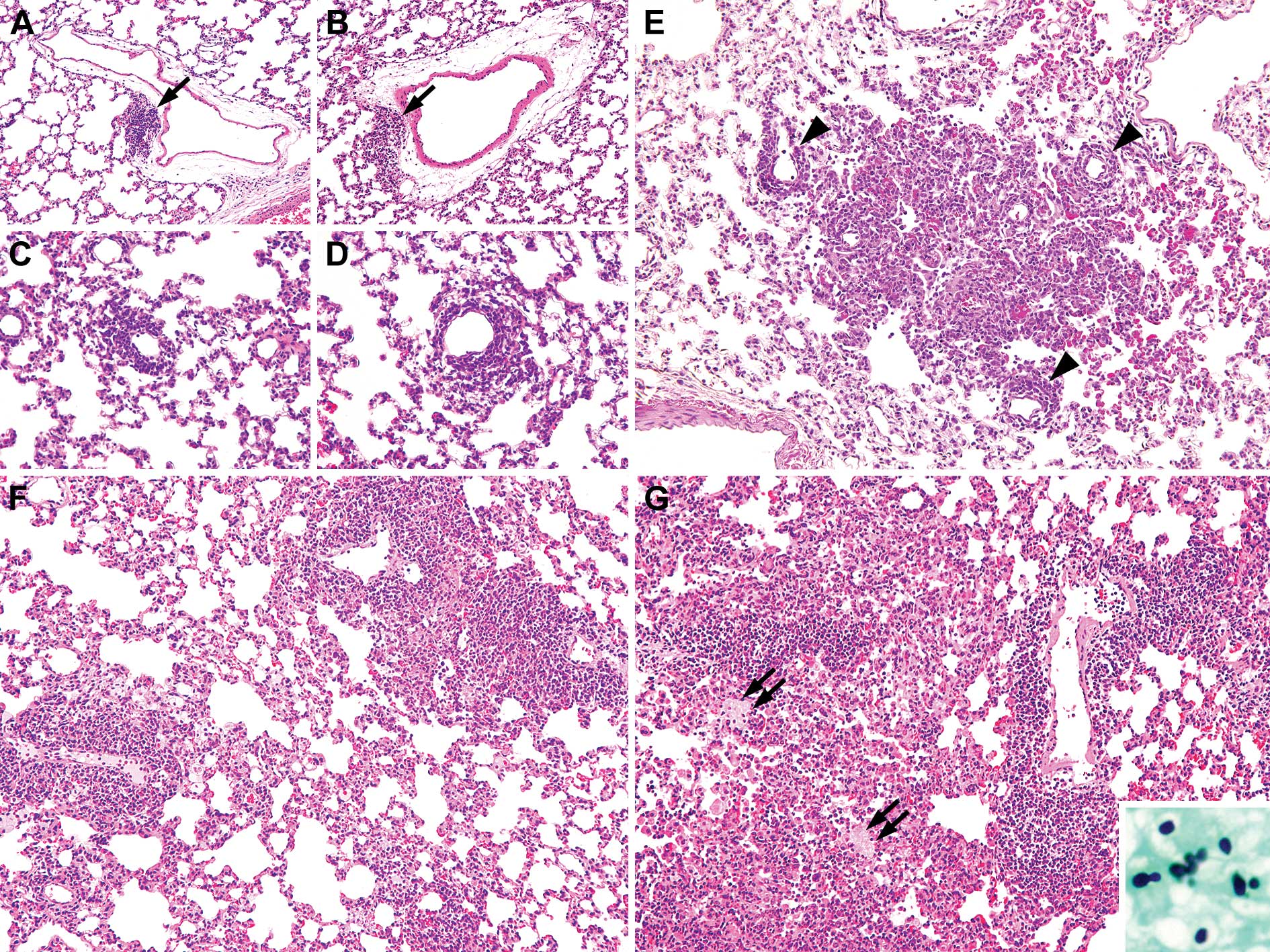|
1
|
Baker DG: Natural pathogens of laboratory
mice, rats, and rabbits and their effects on research. Clin
Microbiol Rev. 11:231–266. 1998.PubMed/NCBI
|
|
2
|
Elwell MR, Mahler JF and Rao GN: ‘Have you
seen this?’ Inflammatory lesions in the lungs of rats. Toxicol
Pathol. 25:529–531. 1997.
|
|
3
|
Slaoui M, Dreef HC and van Esch E:
Inflammatory lesions in the lungs of Wistar rats. Toxicol Pathol.
26:712–714. 1998.PubMed/NCBI
|
|
4
|
Riley LK, Simmons JH, Purdy G, et al:
Research update: Idiopathic lung lesions in rats. ACLAD Newsletter.
20:9–11. 1999.
|
|
5
|
Icenhour CR, Rebholz SL, Collins MS and
Cushion MT: Widespread occurrence of Pneumocystis carinii in
commercial rat colonies detected using targeted PCR and oral swabs.
J Clin Microbiol. 39:3437–3441. 2001.PubMed/NCBI
|
|
6
|
Albers TM, Simon MA and Clifford CB:
Histopathology of naturally transmitted ‘rat respiratory virus’:
progression of lesions and proposed diagnostic criteria. Vet
Pathol. 46:992–999. 2009.
|
|
7
|
Livingston RS, Besch-Williford CL, Myles
MH, et al: Pneumocystis carinii infection causes lung
lesions historically attributed to rat respiratory virus. Comp Med.
61:45–59. 2011.
|
|
8
|
Henderson KS, Dole V, Parker NJ, et al:
Pneumocystis carinii causes a distinctive interstitial
pneumonia in immunocompetent laboratory rats that had been
attributed to ‘rat respiratory virus’. Vet Pathol. 49:440–452.
2012. View Article : Google Scholar
|
|
9
|
Pritchett-Corning KR, Cosentino J and
Clifford CB: Contemporary prevalence of infectious agents in
laboratory mice and rats. Lab Anim. 43:165–173. 2009. View Article : Google Scholar : PubMed/NCBI
|
|
10
|
Walzer PD, Schnelle V, Armstrong D and
Rosen PP: Nude mouse: a new experimental model for Pneumocystis
carinii infection. Science. 197:177–179. 1977. View Article : Google Scholar : PubMed/NCBI
|
|
11
|
Hughes WT: Natural mode of acquisition for
de novo infection with Pneumocystis carinii. J Infect Dis.
145:842–848. 1982. View Article : Google Scholar : PubMed/NCBI
|
|
12
|
Walzer PD, Schultz MG, Western KA and
Robbins JF: Pneumocystis carinii pneumonia and primary
immune deficiency diseases. Natl Cancer Inst Monogr. 43:65–74.
1976.
|
|
13
|
Deerberg F, Pohlmeyer G, Wullenweber M and
Hedrich HJ: History and pathology of an enzootic Pneumocystis
carinii pneumonia in athymic Han:RNU and Han:NZNU rats. J Exp
Anim Sci. 36:1–11. 1993.
|
|
14
|
Pohlmeyer G and Deerberg F: Nude rats as a
model of natural Pneumocystis carinii pneumonia: sequential
morphological study of lung lesions. J Comp Pathol. 109:217–230.
1993.PubMed/NCBI
|
|
15
|
An CL, Gigliotti F and Harmsen AG:
Exposure of immunocompetent adult mice to Pneumocystis
carinii f. sp muris by cohousing: growth of P
carinii f. sp muris and host immune response. Infect
Immun. 71:2065–2070. 2003.PubMed/NCBI
|
|
16
|
Gigliotti F, Harmsen AG and Wright TW:
Characterization of transmission of Pneumocystis carinii f.
sp muris through immunocompetent BALB/c mice. Infect Immun.
71:3852–3856. 2003.PubMed/NCBI
|
|
17
|
Vestereng VH, Bishop LR, Hernandez B, et
al: Quantitative real-time polymerase chain-reaction assay allows
characterization of Pneumocystis infection in
immunocompetent mice. J Infect Dis. 189:1540–1544. 2004. View Article : Google Scholar : PubMed/NCBI
|
|
18
|
Soulez B, Dei-Cas E, Charet P, et al: The
young rabbit: a nonimmunosuppressed model for Pneumocystis
carinii pneumonia. J Infect Dis. 160:355–356. 1989. View Article : Google Scholar : PubMed/NCBI
|
|
19
|
Chabé M, Dei-Cas E, Creusy C, et al:
Immunocompetent hosts as a reservoir of Pneumocystis
organisms: histological and RT-PCR data demonstrate active
replication. Eur J Clin Microbiol Infect Dis. 23:89–97. 2004.
|
|
20
|
Cushion MT, Kaselis M, Stringer SL and
Stringer JR: Genetic stability and diversity of Pneumocystis
carinii infecting rat colonies. Infect Immun. 61:4801–4813.
1993.PubMed/NCBI
|
|
21
|
Weisbroth SH, Geistfeld J, Weisbroth SP,
et al: Latent Pneumocystis carinii infection in commercial
rat colonies: comparison of inductive immunosuppressants plus
histopathology, PCR, and serology as detection methods. J Clin
Microbiol. 37:1441–1446. 1999.PubMed/NCBI
|
|
22
|
Besselsen DG, Franklin CL, Livingston RS
and Riley LK: Lurking in the shadows: emerging rodent infectious
diseases. ILAR J. 49:277–290. 2008. View Article : Google Scholar : PubMed/NCBI
|
|
23
|
Icenhour CR, Rebholz SL, Collins MS and
Cushion MT: Early acquisition of Pneumocystis carinii in
neonatal rats using targeted PCR and oral swabs. J Eukaryot
Microbiol (Suppl). 135S–136S. 2001.
|
|
24
|
Vestereng VH, Bishop LR, Hernandez B, et
al: Quantitative real-time polymerase chain reaction assay allows
characterization of Pneumocystis infection in
immunocompetent mice. J Infect Dis. 189:1540–1544. 2004. View Article : Google Scholar : PubMed/NCBI
|
|
25
|
Weisbroth SH: Pneumocystis: newer
knowledge about the biology of this group of organisms in
laboratory rats and mice. Lab Anim (NY). 35:55–61. 2006. View Article : Google Scholar
|
|
26
|
Cushion MT, Keely SP and Stringer JR:
Molecular and phenotypic description of Pneumocystis
wakefieldiae sp nov, a new species in rats. Mycologia.
96:429–438. 2004.PubMed/NCBI
|
|
27
|
Morris A, Wei K, Afshar K and Huang L:
Epidemiology and clinical significance of Pneumocystis
colonization. J Infect Dis. 197:10–17. 2008. View Article : Google Scholar
|















